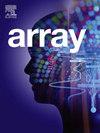RiceKernelEngine: Benchmarking transfer learning models for microscopic images of rice kernel
IF 4.5
Q2 COMPUTER SCIENCE, THEORY & METHODS
引用次数: 0
Abstract
Rice serves as a principal dietary staple food nationwide. The high demand for this cereal grain has led to extensive research, resulting in the frequent development of new grain varieties. Proper cultivation time, region, and nurturing techniques specific to each rice variety can significantly boost production. However, the subtle differences distinguishing one rice grain from another make the classification of rice kernels a resource-intensive and exhaustive task. Our proposed approach explores the potential for automated classification of five different rice varieties developed in Bangladesh: BINADHAN-8, BINADHAN-23, BRRI-67, BRRI-74, and BRRI-102. These varieties are highly similar in appearance, and state-of-the-art transfer learning models have been employed to assess their practical feasibility. The dataset comprises 3155 images, with classes containing 605, 578, 642, 695, and 635 images, respectively. The implemented models—VGG19, MobileNetV3, EfficientNet, and ConvNeXt—achieved accuracies of 85%, 94%, 96%, and 87%, respectively, with an average accuracy of 90.50%. The results indicate the practical applicability of these models in this field, with EfficientNet providing the highest accuracy rate for classifying rice grains. This study utilized an exclusive, self-obtained dataset of microscopic rice grain images. An autonomous and efficient classification system will benefit rice farmers and open new research opportunities for agriculturists and other stakeholders.
rice kernelengine:稻米显微图像的基准迁移学习模型
大米是全国人民主要的主食。对这种谷物的高需求导致了广泛的研究,导致了谷物新品种的频繁开发。适当的栽培时间,区域和培育技术,具体到每个水稻品种可以显著提高产量。然而,区分一粒米与另一粒米的细微差异使得稻粒分类成为一项资源密集型和详尽的任务。我们提出的方法探索了孟加拉国5个不同水稻品种的自动分类潜力:BINADHAN-8、BINADHAN-23、BRRI-67、BRRI-74和BRRI-102。这些品种在外观上非常相似,最先进的迁移学习模型被用来评估它们的实际可行性。数据集包含3155张图像,类分别包含605张、578张、642张、695张和635张图像。所实现的模型vgg19、MobileNetV3、EfficientNet和convnext的准确率分别为85%、94%、96%和87%,平均准确率为90.50%。结果表明了这些模型在该领域的实际适用性,其中effentnet对稻谷分类的准确率最高。本研究利用了一个独家的、自获得的显微稻米图像数据集。一个自主和有效的分类系统将使稻农受益,并为农业学家和其他利益相关者开辟新的研究机会。
本文章由计算机程序翻译,如有差异,请以英文原文为准。
求助全文
约1分钟内获得全文
求助全文

 求助内容:
求助内容: 应助结果提醒方式:
应助结果提醒方式:


